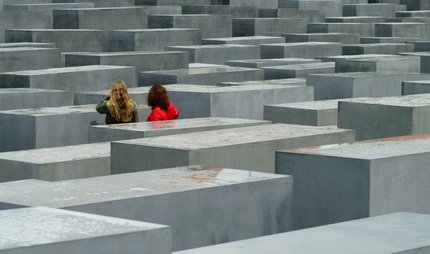
Block of Women
Memorial to the Rosenstraße Protest
Between the Hackescher Markt and Alexanderplatz runs Rosenstraße, which together with the Heidereutergasse provides the boundary of a small park in the Marienviertel of old Berlin. There, on the former site of the Old Synagogue destroyed in World War II, stands the "Block of Women" memorial to the women's uprising of 1943. Some 8,000 Jewish citizens of Berlin were detained at the end of February 1943 as part of a renewed wave of deportations by the SS and the Gestapo. This included some 2,000 Jews, mostly men, who were partners in mixed marriages which had until then been tolerated and spared from persecution. Separated from the rest of the prisoners, they were taken to the building which had formerly housed the Jewish Welfare Administration in Rosenstraße 2-4. Out of desperation and dismay about the uncertain fate of their husbands and fathers, the women gathered in front of the building with their children on the evening of 27 February 1943 and demanded to speak with their loved ones. There followed a later call for the release of their family members from the so-called "Factory Action", the euphemism used to denote the final round-up of Berlin's Jews in 1943. For a week, some 600 women engaged in daily protests.
On 6 March 1943, the first prisoners were released, with the remaining detainees released in the following days. The women's protest was peaceful and none of those involved were punished. Today, a sculpture created by Ingeborg Hunzinger serves as a monument to the courage of the women who put their lives at risk to secure the freedom of their husbands. Furthermore, the monument stands as a reminder of the day-to-day discrimination and ethnic persecution and its ultimate consequences for the Jewish culture. The monument consists of six elements: three reddish sandstone blocks with carved Jewish characters, texts and symbols form a semicircle around a couple lying in each other's arms. Two of these blocks have been staged as torn apart and yet assembled into a unit. From one part emerges a man turned towards a woman emerging from the other part. This scene is symbolic of the events surrounding the women's protests on Rosenstraße. Other characters portray desperation and fear, but also the cohesion and unity of the Jewish people against the totalitarian regime. A man standing to the side holding a broken violin depicts how the Nazi dictatorship destroyed the Jewish culture. Opposite is a sculpture seated on a park bench, a poignant reminder that Jews were forbidden to sit on benches at the time.


